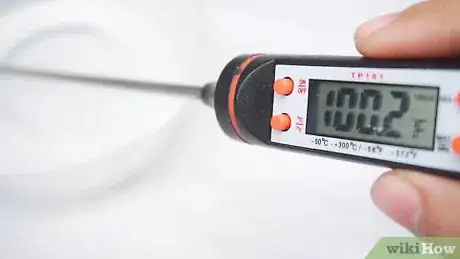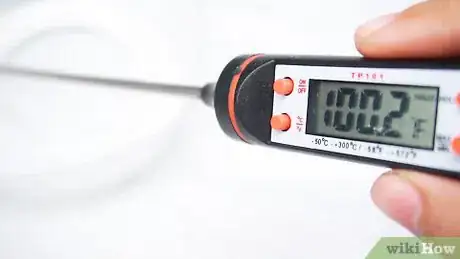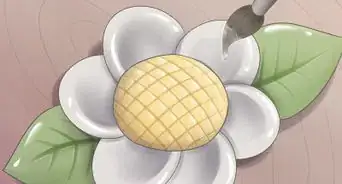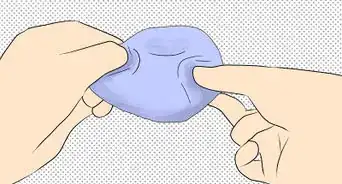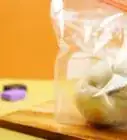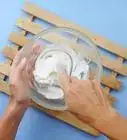This article was co-authored by wikiHow staff writer, Hunter Rising. Hunter Rising is a wikiHow Staff Writer based in Los Angeles. He has more than three years of experience writing for and working with wikiHow. Hunter holds a BFA in Entertainment Design from the University of Wisconsin - Stout and a Minor in English Writing.
The wikiHow Video Team also followed the article's instructions and verified that they work.
This article has been viewed 292,058 times.
Learn more...
Plaster of Paris is a simple craft material that can be easily made at home. All you need is flour and water, or glue and water if you'd rather not handle flour. Once you've made it, you can use it to make plaster casts, molds, or even chalk!
Steps
Making Plaster of Paris from Flour
-
1Heat 1 cup (240 ml) to 100 °F (38 °C). Warm water works best to help speed up the process. Use either a microwave or a stove to heat the water to the correct temperature.[1]
-
2Combine the water with 2 cups (256 g) of flour in a mixing bowl. Pour the water over the flour as evenly as you can. Once all the water is added, start stirring the mix with a spoon or spatula.[2]
- If you’re worried about dried plaster sticking to your utensils, use a disposable plastic spoon.
Advertisement -
3Stir the mixture with a spatula until there are no lumps. The consistency should be a thick white paste when you’re finished. In the end, the plaster should be thick, but not difficult to stir. If it seems too thick, add more water. If it is too runny, add more flour until it thickens.
-
4Work with the plaster within 10 minutes. You’ll notice the plaster mixture will start to solidify as you work with it. Pour the mixture into your molds as soon as you’ve finished stirring it for the best results.
-
5Let the plaster set for 48 hours. The plaster may seem to dry within 24 hours, but it will not be completely set through. Allow it to sit at room temperature for 2-3 days to dry.[3]
Using Glue
-
1Heat 2 to 3 cups (470 to 710 ml) of water to 100 °F (38 °C). Use a microwave or stove to heat the water to temperature.
-
2Mix 1 cup (240 ml) of water with 2 cups (470 ml) of school glue. Pour the water and glue into a mixing bowl and stir them together thoroughly with a spatula. Stir in a little water at a time until the plaster has a soupy consistency.[4]
-
3Work with the plaster within 15 minutes. Making plaster with glue will make it have a slightly longer drying time, but you should still work with it as soon as you finish mixing it. Pour it into molds to form the shape you want.[5]
-
4Let the plaster set for 48-72 hours. Since plaster with glue takes longer to cure, it may take up to 3 days for the plaster cast to completely dry. Keep it at room temperature for an even and thorough dry.[6]
Community Q&A
-
QuestionHow do I make mod roc?
 T. ChinsenTop AnswererWet strips of muslin and soak them in a container of liquid plaster of Paris. Allow the plaster to soak into the fabric before using. You can also use gauze for a lighter layer of mod roc.
T. ChinsenTop AnswererWet strips of muslin and soak them in a container of liquid plaster of Paris. Allow the plaster to soak into the fabric before using. You can also use gauze for a lighter layer of mod roc. -
QuestionI have a vintage plaster cat. The tail and part of the front legs have broken off. Can plaster of paris be moulded to the forms needed and subsequently be attached to the tail and legs?
 FiRECommunity AnswerYes, if you have the kind of mould. Do you have a piece of the broken legs and the tail? if you do, then you could either “glue” them back on with plaster or fill them as a mould.
FiRECommunity AnswerYes, if you have the kind of mould. Do you have a piece of the broken legs and the tail? if you do, then you could either “glue” them back on with plaster or fill them as a mould.
Warnings
- Do not wash leftover plaster of Paris into the sink since it may clog your pipes. Instead, let it harden and then throw it in the trash.⧼thumbs_response⧽
- Plaster of Paris dries quickly, so wash it off immediately if it comes into contact with your skin.⧼thumbs_response⧽
- Don't use any part of your body as a mould otherwise it will be very hard to get it back out.⧼thumbs_response⧽
Things You’ll Need
- Measuring cup
- Mixing bowl
- Spatula
- All-purpose flour
- Warm water
- Stovetop or microwave
- School glue
- Molds for your plaster
References
- ↑ https://www.kidsplayandcreate.com/make-your-own-plaster-of-paris/
- ↑ https://www.kidsplayandcreate.com/make-your-own-plaster-of-paris/
- ↑ http://www.observationsblog.com/sciencetechnologyexperiments/plaster-of-paris-mixing-guide
- ↑ https://www.kidsplayandcreate.com/make-your-own-plaster-of-paris/
- ↑ https://www.kidsplayandcreate.com/make-your-own-plaster-of-paris/
- ↑ http://www.observationsblog.com/sciencetechnologyexperiments/plaster-of-paris-mixing-guide
- ↑ https://www.firstpalette.com/tool_box/quick_how_to/plasterofparismixture/plasterofparismixture.html
About This Article
To make plaster of paris, first cover your work surface with newspaper. Then, heat 1 cup (250 mL) of water to 100°F (38°C) in the microwave. Mix in 2 cups (255 grams) of flour with a spatula until there are no lumps. If the paste is too thick, add more water. If it’s too runny, add more flour. The mixture will be ready when it is thick but still easy to stir. Make sure to use the plaster within 10 minutes before it fully solidifies. Then, let the plaster sit for at least 48 hours at room temperature to fully dry. To make plaster of paris with glue instead of flour, heat 1 cup (240 mL) of water to 100°F (38°C). In a mixing bowl, combine the water with 2 cups (470 mL) of white school glue. The resulting plaster will have a soupy consistency. Use this plaster within 15 minutes and let it set 3 days to completely dry. For more tips, including how to use glue to make a plaster, read on!
